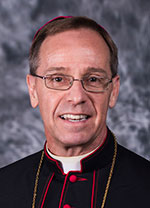Christ the Cornerstone
Sainthood of Blessed Pope Paul VI is a time to rejoice

“Love is total—that very special form of personal friendship in which husband and wife generously share everything, allowing no unreasonable exceptions and not thinking solely of their own convenience. Whoever really loves his partner loves not only for what he receives, but loves that partner for the partner’s own sake, content to be able to enrich the other with the gift of himself”
(Blessed Pope Paul VI, “Humanae Vitae,” #9).
In just a few weeks, Blessed Pope Paul VI, who died 40 years ago on Aug. 6, 1978, will be officially declared a saint by one of his successors, Pope Francis. This will be an occasion of great joy for our Church that is once again suffering from the suspicion and doubt caused by the failures of bishops in many different regions of the world, including our own country.
Giovanni Battista Montini, later Pope Paul VI, served as a priest and bishop in his native Italy. He was elevated to the College of Cardinals in 1958 and was elected pope in 1963, following the death of St. Pope John XXIII. He served as pope for 15 years until his death.
For those who are old enough to remember, those years were full of emotional, social and political ups and downs. The enthusiasm of the Second Vatican Council gave way to confusion over the implementation of its teaching. Traditional religious and moral values seemed to be superseded by forms of cultural relativism, and sexual mores—aided by new forms of technology—were being radically transformed.
Blessed Paul VI was sometimes severely criticized (even publicly mocked) for his fidelity to the Church’s understanding of the fundamental dignity of the human person and the meaning of human sexuality. Anyone who reads this pope’s writing—his numerous homilies, speeches and pastoral communications—can see that he was not rigid or closed-minded.
In fact, he cared deeply about the people of God, and he was passionate about the work of evangelization, which he saw as sharing God’s love with everyone, especially the young.
In the encyclical “Humanae Vitae” (“Of Human Life: on the Regulation of Birth”) which was published 50 years ago on July 29, 1968, Paul VI affirmed the traditional teaching of the Church regarding married love, responsible parenthood, and the rejection of artificial contraception. Needless to say, “Humane Vitae” was—and still is—controversial. But the five decades that have passed since its promulgation have more than validated the encyclical’s prophetic teaching.
Today, the Church’s teaching on the meaning of human sexuality—especially the inseparable connection between the love of wife and husband and their participation in God’s procreative work—can seem hopelessly old-fashioned. In reality, it is a refreshingly new way of understanding the physical intimacy and spiritual depth of married love.
The sacramental view of marriage, which our Church professes in spite of all efforts to redefine its meaning, regards the union of a man and a woman as something sacred that involves more than just the union of two people.
Marriage is much more than a social contract or a convenient form of cohabitation. It is something holy—the union of a loving couple with their loving God. And the children who are born of this sacred union are doubly blessed because they are children of God and children of parents who have committed themselves totally to doing God’s will.
During his 15 years as a successor of St. Peter, Paul VI frequently taught that each human person has been made in the image and likeness of God. In many ways, he initiated the modern papal themes of tenderness and mercy. He stressed that Christian life is more inclined to “messages of trust” than to rigid or forbidding rules and regulations. Especially when dealing with young people, Paul VI focused on communicating an “intelligent and free faith, a culture thirsting for truth and open to dialogue.”
The ordinary process for the canonization of a saint requires that two miracles be verifiably attributed to the person being considered for sainthood. In the case of Blessed Pope Paul VI, both miracles concern the lives of unborn children.
In two separate cases, fetuses which had no hope of being born without being seriously deformed, or with a very slim chance of survival outside the womb, were entrusted to Paul VI, the protector of unborn life. Both were miraculously born as healthy infants thanks to their parents’ fervent prayers and the intercession of this holy man, soon to be our next great papal saint.
Let’s rejoice with the whole Church on Oct. 14. Let’s pray that the prophetic teaching of Pope Paul VI will prevail in the years ahead. †
